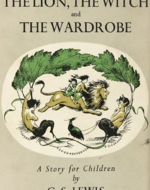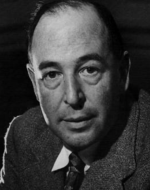Created by Meghan Wax on Fri, 10/11/2024 - 13:42
Description:
Children today still enjoy the fantastical adventures of Lucy, Susan, Edmund, and Peter Pevensie in The Chronicles of Narnia series. Beginning with The Lion, the Witch, and the Wardrobe (1950), C. S. Lewis has created a series of magical stories for children, encouraging them to travel beside the child protagonists to journey through an enchanted wardrobe filled with fur coats into the wondrous world of Narnia. Despite the popularity of The Lion, the Witch, and the Wardrobe, some parents, teachers, and librarians raise concerns about various aspects of the book. In fact, book bans have even been put in place over the years in some schools and libraries due to The Lion, the Witch, and the Wardrobe's implications of violence, gore, and mysticism. Some non-Christian parents don't want their children reading about Christian ideals, and some Christian parents disapprove of their children learning Biblical stories through a magical adventure book with talking animals and witches. However, despite many critics' claims, Lewis never intended to impose Christianity on children. Rather, he sought to craft a unique fantasy world for children to explore and enjoy.
As a lover of fairy tales, Lewis first composed the magical story of The Lion, the Witch, and the Wardrobe, and when he later discovered he was intertwining Christian ideas into his writing, he decided to expand on them instead of cutting them out. Over the course of his life, Lewis lost his connection to religion but found it again. His objective for The Chronicles of Narnia series was to provide children an outlet to explore Christianity in a way they might not be able to at church. In an essay entitled "Sometimes Fairy Stories May Say Best What’s to Be Said," Lewis writes, "I thought I saw how stories of this kind could steal past a certain inhibition which had paralysed much of my own religion in childhood. Why did one find it so hard to feel as one was told one ought to feel about God or about the sufferings of Christ? I thought the chief reason was that one was told one ought to. An obligation to feel can freeze feelings . . . But supposing that by casting all these things into an imaginary world, stripping them of their stained-glass and Sunday school associations, one could make them for the first time appear in their real potency? Could one not thus steal past those watchful dragons? I thought one could" (Ditchfield Lazo par. 11). While earlier authors of didactic Christian texts, including John Bunyan, sought to improve their readers by instilling in them the fear of God, their parents, and potential punishment, Lewis wrote The Lion, the Witch and the Wardrobe primarily to entertain and encourage readers not only to use their imagination, but also to forge their own understanding about religion and God.
Ditchfield Lazo, Christin. “Biblical Truths in C.S. Lewis’s The Chronicles of Narnia.” C.S. Lewis Institute, 2023, www.cslewisinstitute.org/resources/biblical-truths-in-cs-lewis-the-chron....
Book Cover of The Lion, the Witch and the Wardrobe (1950), by C.S. Lewis, published by Geoffrey Bles, illustrated by Pauline Baynes, Wikipedia. The story begins when four children--Lucy, Susan, Edmund, and Peter Pevensie--relocate to the countryside during WWII. They are staying with a strange and mysterious professor in his strange and mysterious home. Perhaps what's most unique about the large house is its wardrobe that transports the children to the enchanting world of Narnia, a very different world from what the children leave behind. Animals talk, magical creatures exist, and it's always winter but never Christmas. The children soon learn, however, that Narnia hasn't always been stuck in a state of perpetual bitter coldness. An evil White Witch has placed a curse over Narnia and has taken control, turning anyone who questions her authority to stone. While many of Narnia's creatures have been shivering from the snow and hiding in fear for much too long, the sight of Lucy, Susan, Edmund, and Peter gives them hope. They refer to the children as the sons of Adam and the daughters of Eve and inform them of the prophecy that "When Adam's flesh and Adam's bone / Sits at Cair Paravel in throne, / The evil time will be over and done" (Lewis 81). Paired with the rumors that Aslan--a spiritual lion who holds great power and is a representation of Jesus--is on the move, the children's arrival in Narnia rallies the fantastical country's residents to prepare for battle in order to defeat the White Witch and return peace and prosperity to the land. This book cover illustrated by Pauline Baynes depicts Susan and Lucy riding on Aslan’s back on their quest to save Narnia while being observed by other faun-like creatures.
Lewis, C. S.. The Lion, the Witch and the Wardrobe. Scholastic Inc., 1950.
"Lewis in 1947," scanned by Arthur Strong, 1947, Wikipedia. C. S. Lewis, born Clive Staples Lewis (1898-1963), was a theologian in addition to a writer and scholar. Born in Belfast, Lewis grew up reading and writing stories about anthropomorphic animals. He was especially fascinated by Beatrix Potter's tales of the adventures of various woodland creatures. Lewis was raised as a Christian but abandoned religion and became an atheist in his teenage years, instead taking interest in Norse Mythology. It wasn't until after Lewis studied at Oxford, joined the Officer Training Corps, fought in France, and returned to Oxford to teach that Christianity became an important part of his life again. At Oxford, Lewis taught alongside fantasy author and scholar J. R. R. Tolkein, who was a Roman Catholic; Tolkein and a circle of other Christian scholars convinced him of God's existence by relating Biblical stories to the myths of pagan gods that so enchanted enchanted Lewis. Soon, Christianity started to appear in Lewis's writing in both direct and indirect ways. Lewis's first book after his readoption of religion, The Pilgrim's Regress, followed a similar story arc as John Bunyan's The Pilgrim's Progress and detailed Lewis's transition from atheism to Christianity. In less obvious ways, Christian ideas weaved their way into Lewis's The Chronicles of Narnia series, beginning with The Lion, the Witch and the Wardrobe.
Photographs of the Narnia Door and Lamppost at Oxford, courtesy of Dr. Catherine J. Golden, 2023. Lewis and Tolkein both lectured at Oxford University, with Lewis teaching English Literature at Magdalen College. Although the two scholars had very different personalities, they bonded quickly over their love of magic and myths. Even though the genre of fantasy was looked down upon in academia, Lewis and Tolkein didn't shy away from writing what they loved, and the atmosphere at Oxford greatly influenced Lewis's conception of The Lion, the Witch and the Wardrobe. These photographs of the Narnia door and lamppost at Oxford demonstrate how Lewis's surroundings found themselves chronicled in his fantastical stories. The Narnia door is decorated with an intricate engraving that greatly resembles Aslan, the lion, and embellishments of faun-like creatures that look like Mr. Tumnus. Additionally, nearby the door stands a lamppost that likely inspired Lewis's creation of the lamppost in Narnia where Lucy Pevensie first meets Mr. Tumnus. However, not only did Lewis's whimsical environment impact his writing of The Lion, the Witch and the Wardrobe but so also did his relationship with Tolkein. The two authors shared their work with one another and critiqued each other's writing, which eventually led to the formation of the Inklings in the 1930s. The Inklings were a group of writers from various professions who shared a fondness of fantasy and Christianity. They met twice a week to share what they were working on, holding the writers responsible for finishing their stories. The Inklings were very encouraging of one another's work, and Tolkein confessed he didn't know if he would have finished writing The Lord of the Rings without Lewis's support. Not only did Lewis and Tolkein impact one another's writing, but they also majorly influenced the work of their students. One of their students in particular, Diana Wynne Jones, was an accomplished fantasy author for children and adults who studied under both Lewis and Tolkein at Oxford. She recalled Lewis's lectures being insightful and full of life and Tolkein's being purposely drab, monotone, and impossible to hear since he was trying to weed out students, so he'd have more time to work on The Lord of the Rings. Jones, however, refused to be discouraged and remained in Tolkein's class with only one other student. Jones learned important lessons from Lewis and Tolkein, including how to write for children and how to create a mutating plot, which significantly impacted her writing. Lewis and Tolkein's stories and lectures forever altered the fantasy and children's book genres as evidenced by the magical works of their many students and readers.
Pauline Baynes, "Lucy with Mr. Tumnus and his Umbrella," from The Lion, the Witch and the Wardrobe by C. S. Lewis, 1950, Source from Maria Antonia. Lewis was and continues to this day to be criticized for his The Chronicles of Narnia series both being too Christian and not noticeably Christian enough. In his essay, "Sometimes Fairy Stories May Say Best What’s to Be Said," Lewis responds to some of these judgements, stating, "'Some people seem to think that I began by asking myself how I could say something about Christianity to children; then fixed on the fairy tale as an instrument; then collected information about child-psychology and decided what age-group I’d write for; then drew up a list of basic Christian truths and hammered out 'allegories' to embody them. This is all pure moonshine. I couldn’t write in that way at all. Everything began with images; a faun carrying an umbrella, a queen on a sledge, a magnificent lion. At first there wasn’t even anything Christian about them; that element pushed itself in of its own accord'" (Ditchfield Lazo par. 6). Always intrigued by fantastical worlds and creatures, Lewis had powerful visions of magical characters, and Baynes realizes them in this illustration of young Lucy with the faun, Mr. Tumnus, holding his umbrella, one of the first images Lewis had for The Lion, the Witch, and the Wardrobe. The kind hearted but misguided faun leads Lucy to his cave, holding the umbrella over her head to keep her dry from the snow falling from the frozen trees of Narnia. While Mr. Tumnus tells Lucy she is invited to his cave for tea, he is really capturing her, so he can lull her to sleep and turn her over to the White Witch. Lucy's interaction with Mr. Tumnus is a major catalyst of the children's adventures in Narnia, mirroring how Lewis's image of a faun with an umbrella spurred the writing of The Lion, the Witch and the Wardrobe.
Ditchfield Lazo, Christin. “Biblical Truths in C.S. Lewis’s The Chronicles of Narnia.” C.S. Lewis Institute, 2023, www.cslewisinstitute.org/resources/biblical-truths-in-cs-lewis-the-chron....
The Chronicles of Narnia Movie Posters from The Lion, the Witch, and the Wardrobe (2005), Prince Caspian (2008), and The Voyage of the Dawn Treader (2010), Narniaweb. The adventures of the Pevensie children and other residents of Narnia aren't confined to just one book. After the huge success of The Lion, the Witch and the Wardobe's publication, Lewis published six more books in The Chronicles of Narnia series over the next six years, including a prequel entitled The Magician's Nephew. Young readers have the opportunity to explore exciting new parts of Narnia in every book and accompany both newly introduced and beloved characters on magical quests, expeditions, and trials. In 2005, the film adaptation of The Lion, the Witch, and the Wardrobe directed by Andrew Adamson was released, followed by Prince Caspian in 2008, and The Voyage of the Dawn Treader directed by Michael Apted in 2010. These three high grossing films brought Lewis's words to life with screenplays paying homage to his original works and incredible special effects, costuming, and acting, realistically expanding Lewis's stories beyond the page. The Lion, the Witch, and the Wardrobe has additionally been adapted into a musical with a script by Jules Tasca, and music by Thomas Tierney, and lyrics by Ted Drachman; excitingly, director Greta Gerwig has recently made a deal with Netflix to write and direct at least two movies based on Lewis's Narnia stories. While over seventy years have passed since the publication of The Lion, the Witch, and the Wardrobe, Lewis's work is certainly not being forgotten and Netflix prepares to introduce a whole new generation of readers and imaginers to the magical world of Narnia.
Copyright:
Associated Place(s)
Featured in Exhibit:
Artist:
- Pauline Baynes






